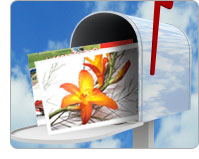- Products
-
Design Templates
- Featured Design Galleries
- More Galleries
- Services & Resources
- Free Sample Kit
- Deals
 Postcards are the cheapest — and one of the most effective — forms of direct-mail marketing today. Great postcards hit your prospects fast and elicit an immediate impression since they don't have to tear through an envelope to get to the meat of your benefits and offer. Direct-mail postcard campaigns decrease the likelihood that your prospects will throw your promotional pieces away before reading them, and increase the chance that they'll follow through and respond. Like all forms of direct mail, postcard marketing campaigns depend on the right blend of style, substance and value. Here are a few mistakes to avoid for your next direct-mail postcard marketing campaign:
Postcards are the cheapest — and one of the most effective — forms of direct-mail marketing today. Great postcards hit your prospects fast and elicit an immediate impression since they don't have to tear through an envelope to get to the meat of your benefits and offer. Direct-mail postcard campaigns decrease the likelihood that your prospects will throw your promotional pieces away before reading them, and increase the chance that they'll follow through and respond. Like all forms of direct mail, postcard marketing campaigns depend on the right blend of style, substance and value. Here are a few mistakes to avoid for your next direct-mail postcard marketing campaign:
The No. 1 predictor of direct-mail success is the mailing list. Using a poor mailing list will yield few, if any, responses because these prospects aren't likely to benefit from your products and services. It doesn't matter how good your product or service is. Let's say you're selling the next-generation word processing software, for instance, but your mailing list is comprised primarily of people who do not own computers. In this case, you're simply wasting your money. A great mailing list puts your postcard in front of people who already want what you're selling. Make sure you do your research to identify your market by profession, age, income, gender, geographic location and other demographics. Then, make sure your postcard's offer solves a problem or makes life easier for them. If you're not sure where to begin, companies such as PsPrint can help you create the perfect profit-turning mailing list so your postcard campaigns achieve success.
 Great postcard copy includes several different elements and follows certain tenets, one of which is brevity. Compared to other forms of direct-mail marketing, postcards offer relatively little space to share your message. In many cases, all your postcard needs is an attention-grabbing headline, a few factual features/benefits, an offer and a call to action. Other elements, such as testimonials or comparison charts, can also be added but are not necessary. Make sure your headlines stand out and can be read from a distance. Your features and benefits could be bulleted points or weaved into a few short paragraphs. As always, your offer should be enticing and valuable, and your call to action immediate. Make it easy for prospects to respond by offering a free gift, or simply allowing them to request more information. Your postcard copy should be one step of the purchasing process and should not necessarily attempt to make a sale on its own.
Great postcard copy includes several different elements and follows certain tenets, one of which is brevity. Compared to other forms of direct-mail marketing, postcards offer relatively little space to share your message. In many cases, all your postcard needs is an attention-grabbing headline, a few factual features/benefits, an offer and a call to action. Other elements, such as testimonials or comparison charts, can also be added but are not necessary. Make sure your headlines stand out and can be read from a distance. Your features and benefits could be bulleted points or weaved into a few short paragraphs. As always, your offer should be enticing and valuable, and your call to action immediate. Make it easy for prospects to respond by offering a free gift, or simply allowing them to request more information. Your postcard copy should be one step of the purchasing process and should not necessarily attempt to make a sale on its own.
Postcards are a great way to increase brand recognition, but, in most cases, initial postcards (especially to new prospects) will not generate sales. For this reason, a majority of direct-mail postcard campaigns plan for several mailings that build up to the sales pitch. Try sending three or more postcard promotions to the same mailing list, spaced about four to six weeks apart. Once your prospects begin to recognize who you are and what you do, it will be much easier (and more profitable) to close sales.
Postcards are so inexpensive to produce and mail, so they provide an excellent testing environment so you can fine-tune your direct-mail campaigns to achieve the appropriate response — and translate that response into sales. Make sure you develop at least two versions of any postcard, change minor elements (like the headline or offer details), and test them against a small portion of your mailing list. Repeat this cycle until you have a postcard that delivers a predictable and profitable response rate, and send it to the entire list. This will save you money in bulk mailing and printing, and it will almost certainly increase your return on investment dramatically.
Believe it or not, many companies overlook simple misspellings and other errors when approving the final postcard copy. This is a huge mistake, because your prospects will perceive these errors as an indicator of your professionalism — or lack thereof. Even worse, you could get some of the numbers in your offer wrong. Imagine the disastrous fallout if your "10 percent discount" offer was printed as a "100 percent discount" offer. Hire a professional copywriter or proofreader, or, if that's not in your budget, ask friends, family, and co-workers to proofread your promotional postcards for you — before they're printed. If you want to achieve success from your direct-mail marketing efforts without breaking the bank, postcards are the way to go. They're clean, quick and efficient — as long as they're done correctly. Avoid the aforementioned mistakes and do it right the first time with the right mailing list, the right copy and the right pace; and you'll be well on your way to an immediate increase in your return on investment.